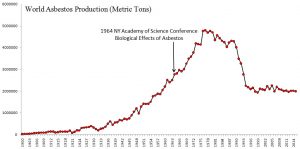When the World Trade Center was being built in 1973, Dr. Irving Selikoff, an expert on asbestosis and cancers caused by asbestos, was an outspoken critic of the wholesale spraying of the floors of the two structures with insulator containing copious quantities of asbestos for fire-proofing. He knew the potential dangerous hazards of asbestos as did the asbestos industry. Fortunately not all floors were insulated because New York City instituted a ban on the spraying of asbestos in the same year. Fast forward almost 30 years when the plumes of dust rolled over lower Manhattan after the collapse of the World Trade Center towers on 9/11. The brave souls that rushed to help survivors and participate in the cleanup along with the many people that lived and worked in the area were exposed to one of the most serious carcinogens ever documented – asbestos in its many forms. One of the most deadly results of inhaling the tiny asbestos fibers that permeated the World Trade Center clouds is the nearly always fatal cancer mesothelioma (known to be caused only by asbestos). Unfortunately, the cancer often shows up decades after exposure. What many people do not realize is that asbestos has still not been banned in the United States even though the asbestos community has known internally since at least the 1930s that it was not only harmful but deadly. The asbestos executives and their hired doctors promulgated a disinformation campaign that asbestos was and is harmless knowing full well that these claims were patently wrong1.
Selikoff first came to prominence in 1964 when he organized an international symposium on the “Biological Effects of Asbestos” through the New York Academy of Sciences. Selikoff, through his position as the director of the Environmental Sciences Laboratory at the Mount Sinai Hospital in New York, was able to persuade the International Association of Heat and Frost Insulators & Asbestos Workers union to provide him with workers’ medical profiles2. He presented four papers at the conference on the results of his epidemiological studies of the union workers. There was no mistaking his results — working with asbestos insulation caused an increase in death by 25 percent from not only mesothelioma but asbestosis, lung cancer and even cancers of the stomach, colon and rectum. His independent research could not be buried by the asbestos industry as they had with their subsidized research, and Selikoff’s results were reported widely in the press. Selikoff’s team even found that insulator workers who smoked were ninety times more likely to get some form of asbestos-related cancer than those workers that did not smoke.
I don’t want to appear sanctimonious, but the dangers due to asbestos Selikoff and others reported in 1964 should have caused the asbestos industry pause – maybe even force them to attempt to improve working conditions. But as in other industries with similar threats, the asbestos executives circled the wagons and then went on the offensive. The Asbestos Textile Institute’s lawyers (the asbsetos industry’s public relation’s arm to promote asbestos products) sent letters to the New York Academy of Sciences and Selikoff warning them about the impact of their “damaging and misleading news stories”. Their smear campaigns began by attacking Selikoff’s medical credentials and the quality of his work. For years, the asbestos industry stalked Selikoff and others at conferences and meetings attempting to undermine their work. More details can be found in Jock McCulloch and Geoffrey Tweedle’s outstanding book entitled Defending the Indefensible: The Global Asbestos Industry and its Fight for Survival.
It is astounding the lengths the asbestos industry went to suppress information they deemed adverse and to circulate disinformation cranked out by their hired doctors and researchers. Asbestos executives also turned to the largest public relations firm in the world – Hill & Knowlton – a sort of hit squad of lawyers with a ubiquitous presence in undermining science damaging to their clients which included Big Tobacco3. But perhaps what can only be described as turpitude, the companies led the disinformation campaigns while laborers in a whole slew of industries from mining to textiles worked in deplorable conditions that caused sickness and death. In the Libby mine in Montana, for example, not only was fibrous asbestos dust so thick in some areas of the open-pit mine it was hard for workers to see each other. The dust blew into the nearby town causing asbestos illness and death to residents (the Libby mine was eventually closed due to the huge number of tort claims by families struck by illness and death related to the operations). It was common for the industry to fire workers that developed asbestosis or cancer to avoid the appearance of illnesses related to asbestos. When it became clear to the industry that mesothelioma was a serious public relations nightmare, their public relation’s machine went into full overdrive focusing on two strategies. 1) Reassuring people that asbestos-related diseases were caused only by the inhalation of large amounts of fiber dust over long periods of time (internal memorandums clearly show that the companies involved knew this was not true). 2) Foisting the argument on the public that mesothelioma was the result of blue asbestos and that other types of asbestos, such as chrysotile, were safe (once again, internal memorandums show that the companies knew this to be patently untrue).
The diagram below shows the world production numbers for asbestos from 1900 through 2015. One might think that the asbestos industry would have been crippled by Selikopf’s research reported in 1964. But production actually increased through the 1960s and went on increasing into the late 1970s before tort claims began to impact the industry. But even today, worldwide production has not decreased below the early 1960s output due mostly to production in developing nations. The diagram is a testimonial to the success of the asbestos industry’s ability to undermine solid scientific research with political clout and the financial resources to promote their agenda – asbestos is safe. We have seen the same thing in many other industries like Big Tobacco with smoking and Exxon with global warming. McCulloch and Tweedle make a salient point: “Put another way, nearly 80 per cent [sic] of world asbestos production in the twentieth century was produced after the world learned that asbestos could cause mesothelioma!”
 Data from Virta4 for 1900 through 2003, Virta for 2004 through 2006 (consumption), and Statista for 2007 through 2015.
Data from Virta4 for 1900 through 2003, Virta for 2004 through 2006 (consumption), and Statista for 2007 through 2015.
Imagine that you are the mayor of a small town dependent on tourism, and doctors in the village are reporting an outbreak of a bacterial disease that is killing 40 percent of those being infected. You decide that reporting the disease to the CDC or WHO would harm the financial health of your town and you seek to suppress the seriousness of the outbreak. You tell tourists they have nothing to worry about and chastise the local news affiliates by telling them they are acting hysterically and causing undue panic. Would anyone deny that you are guilty of a serious criminal act? This is essentially what the asbestos industry did over many decades, and yet no one in the asbestos industry has served a day jail time for their actions. In fact, they were so successful in their disinformation campaign that even today as mentioned above asbestos is not banned in the US even though cheap substitutes exist and asbestos has been banned in other industrial nations such as France and Britain. I asked Dr. Jock McCulloch why and his response is telling: “There is no easy answer to your question nor to the adjacent one as to why 2 million tons of asbestos will be mined and used globally during 2016. One of the key factors has been the corporate corruption of the science (which began in the 1930s) and the other is the baleful behaviour of Canada at international forums- due in the main to federal/Quebec politics. And then there is Russia, its political climate and anti-western reflexes.” Both Canada and Russia have been and are huge producers of asbestos and Canada with the help of scientists at McGill University funded by the asbestos industry (one of the reasons why scientists should remain independent in their research) has been instrumental in persuading other governments to act gingerly against asbestos interests.
Distressing research now shows that trivial exposure to asbestos can cause cancers. The Harvard paleontologist Stephen Jay Gould died of cancer caused by asbestos fibers perhaps from asbestos within ceiling tiles. Actor Steve McQueen died at the age 50 from mesothelioma probably from asbestos exposure when he worked in a break repair shop (breaks are lined with asbestos). Many instances of cancer among family members of miners and other laborers in the asbestos industry have been attributed to exposure to asbestos fibers brought home on clothing. I think about the lives destroyed by asbestos when I read the words of McCulloch and Tweedle: “Central to the strategy was a policy of concealment and, at times, misinformation that often amounted to a conspiracy to continue selling asbestos fibre irrespective of the health risks.” I might add that attempts to force the asbestos industry to warn their workers about the dangers of asbestos were averted. And although most mining and manufacturing has moved out of industrialized nations, the developing world has picked up the slack — places like Swaziland where laborers have few protections and little legal recourse for compensation from asbestos illnesses. Records through litigation have turned up showing that industry officials thought black workers were far less sophisticated than those in the US or Europe about hazards to their health and sought to take advantage of them.
 Stephen Jay Gould
Stephen Jay Gould  Steve McQueen
Steve McQueen
Sadly, the large asbestos companies (18 in all) were able to avoid paying thousands of tort claims in the US by declaring bankruptcy through Chapter 11. Bankruptcy implies that a company is insolvent, but due to the Manville Amendment passed by Congress in 1994 to help the asbestos industry, companies only need to show that future liabilities exceed the assets of the company in order to declare bankruptcy. The insurance companies pulled a similar “fast one” by shuttling liabilities into shell companies that also declared bankruptcy. I am very much for free and open trade but companies should be held responsible for travesties, and the bankruptcy claims are tantamount to highway robbery in my humble opinion. Many of those who lost out on benefits and claims were already on the edge of poverty from unemployment and the medical costs from their ailments. I might also point out that the American taxpayer is the ultimate source of support to these workers and their families because the asbestos companies were able to weasel their way out of their responsibilities to their employees and/or those harmed by their products. It may be important to remind the reader that it is estimated that between 15 to 35 million homes contain Libby asbestos as insulation. Asbestos is a problem that is not going away quickly.
I understand that industries like asbestos employ a large number of people (at one time in the 1960s, more than 200,000 people worked in the asbestos industry) and many of these workers would have difficulties finding new jobs elsewhere if the industries were closed overnight. But there are various steps that should be taken based on what we have learned from the asbestos travesty when future industries are found to be responsible for harm to their workers. 1) It should be a crime to purposely mislead the public and/or workers on safety issues of products. This must include the purposeful undermining of peer-reviewed science. The penalties should be stiff and include jail time. Laws need to be enacted accordingly. 2) Workers and their families need to be informed of the dangers in clear language in order that they may decide whether they wish to take the risk of continued employment in the industry. 3) In cases like asbestos where it is clearly a dangerous hazard, the product should be phased out by substitution of other products and eventually banned. 4) Workers and those impacted by the product should be entitled to compensatory damages through the establishment of funds in negotiations with the government. 5) And finally, American companies should be prohibited from moving their operations to nations that have lax laws that permit workers to be exposed to the hazardous products. If corporate America can’t police itself (and I don’t think they can based on the tales of woe involving tobacco, pesticides, global warming, etc.) the government must step in.
- McCulloch, J. and Tweedale, G. (2008) Defending the Indefensible: The Global Asbestos Industry and its Fight for Survival: Oxford University Press ↩
- Selikoff recruited Dr. E. Cuyler Hammond who had already published his landmark research on the link between smoking and lung cancer ↩
- Oreskes, N. and Conway, E. M. (2010) Merchants of Doubt: Bloomsbury Press ↩
- Virta, R. L. (2006) Worldwide Asbestos Supply and Consumption Trends from 1900 through 2003: USGS Circular 1298 ↩
